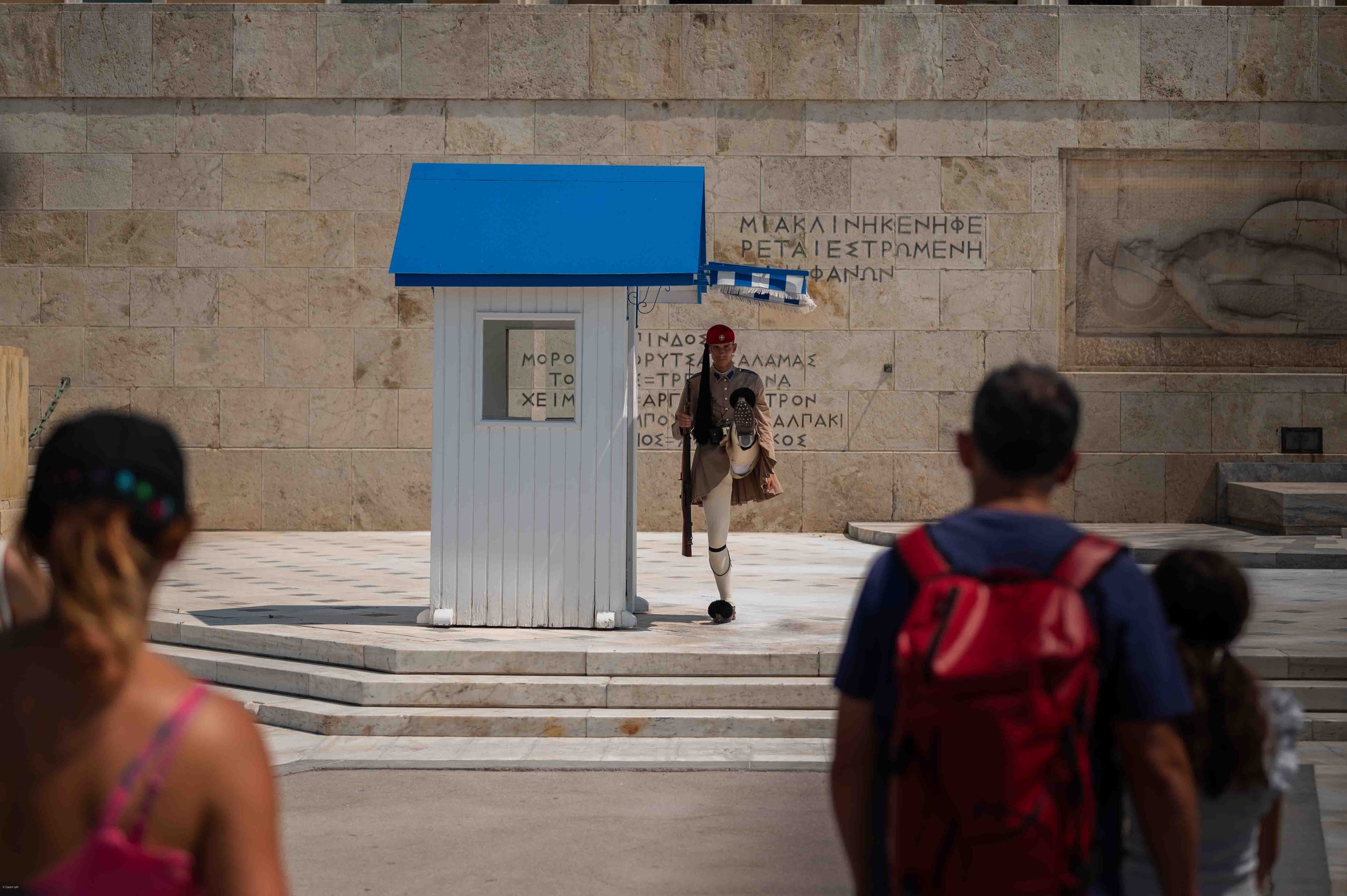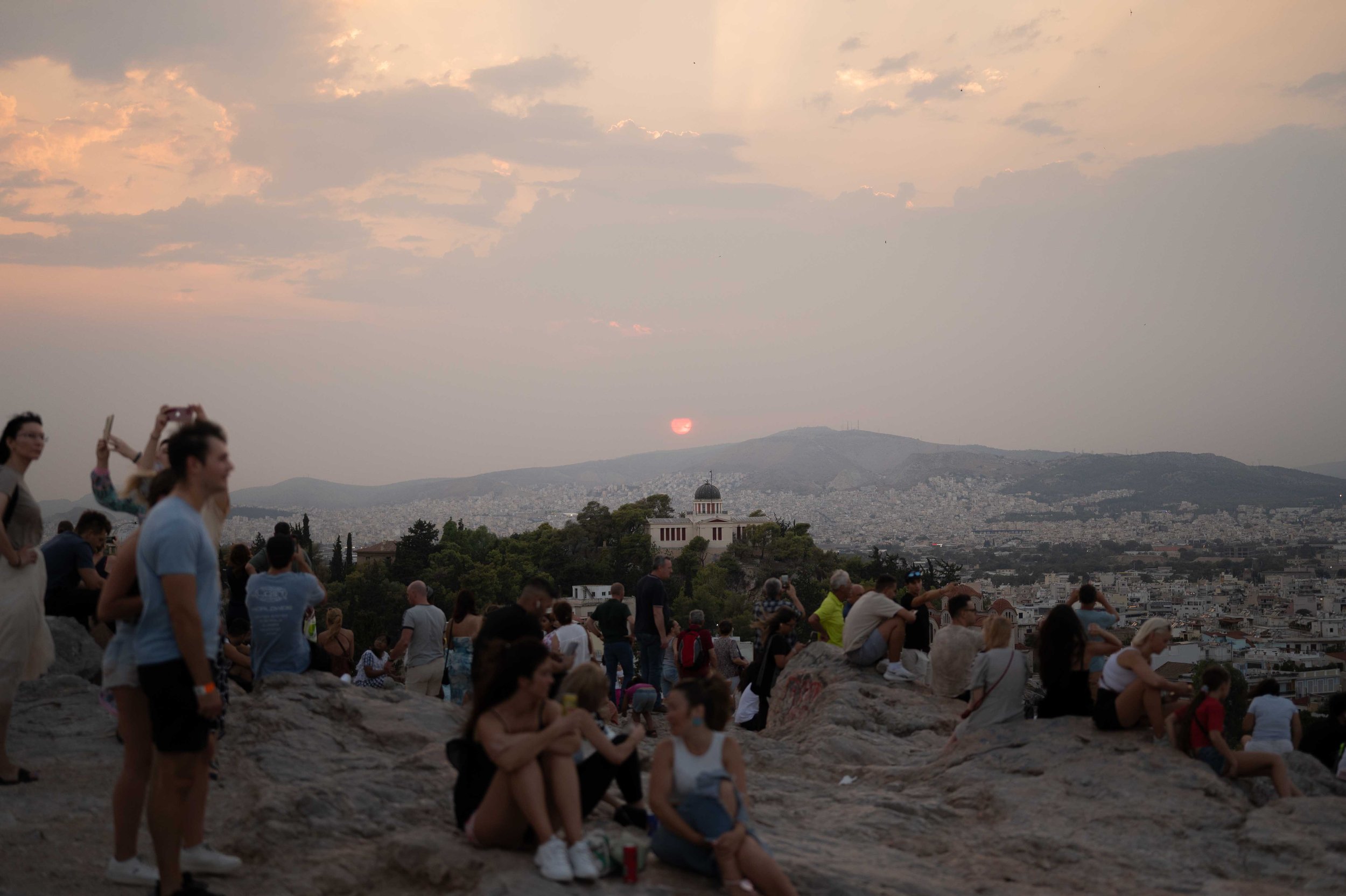Top Things to do in Athens, Greece
Athens is a city where ancient history meets modern vibrancy and where every corner whispers tales of philosophers, gods, and heroes.
In 2023, we found ourselves with a single day to explore this timeless metropolis en route to the serene shores of Milos. Though brief, our stopover in Athens was nothing short of enchanting. From wandering through centuries-old ruins to indulging in delectable Greek cuisine, we were captivated by the city's rich tapestry of sights and sounds.
Below, we list the best things to do in Athens, and if you want more help, we’ve also created a specific itinerary on how to spend the perfect day in Athens here.
Contents
Explore the Historic Sites
Athens is a living museum that chronicles the evolution of Western civilisation. With a recorded history of over 3,400 years, it is one of the world's oldest cities. Known as the cradle of democracy, philosophy, and drama, ancient Athens was a powerhouse of art, knowledge, and political thought.
The remnants of its glorious past offer a connection to the epochs that have shaped human history.
The Acropolis
The Acropolis is Athens' most iconic landmark and a must-visit for anyone exploring the city. Perched high on a rocky hill, this ancient citadel offers breathtaking views over Athens and houses some of Greece's most significant historical structures, including:
The Parthenon
The Erechtheion
Temple of Athena Nike
Odeon of Herodes Atticus
The Parthenon
The Parthenon
Dating back to the 5th century BC, these marvels of ancient Greek architecture are not only impressive in their craftsmanship but are also rich with stories of Greek gods, mythology, and democracy's early foundations.
Make sure you come here as early as possible. Gates open at 08:00, so get here 10 minutes earlier. When we went in 2023, the queues would get incredibly long to visit the Parthenon (we’re talking hours), but know you must buy a timed ticket in advance using the official website here, which should help control the crowds.
Singe visit ticket €20 (Access to: Acropolis & Slopes)
Combined ticket €30 (Access to: Acropolis & Slopes, Ancient Agora, Hadrian's Library, Kerameikos, Aristotle's School [Lyceum], Olympieion, Roman Agora)
Book a week in advance to get the right time slot for you
Takes 1-2 hours
If you want more context about the sites, you can take a guided tour of the Acropolis and Parthenon for around £20 per person.
Odeon of Herodes Atticus
Temple of Olympian Zeus
The Temple of Olympian Zeus, also known as the Olympieion, is a colossal ruined temple dedicated to Zeus, the king of the Greek gods. Construction of the temple began in the 6th century BC under Athenian ruler Peisistratos, but it wasn’t completed until centuries later under the Roman Emperor Hadrian in the 2nd century AD.
Once featuring 104 massive columns—though only 15 remain today—it was the largest temple in Greece at the time and a symbol of divine power and imperial ambition. The towering columns that stand today give visitors a sense of its grand scale and offer a powerful contrast against the backdrop of modern Athens.
Panathenaic Stadium
The Panathenaic Stadium, also known as Kallimarmaro, is a monumental marble stadium with a rich history dating back to ancient Greece. Originally built in the 4th century BC, it was used for the Panathenaic Games, which were held in honor of Athena, the city’s patron goddess.
The stadium we see today was reconstructed in the 19th century for the first modern Olympic Games in 1896, making it a unique blend of ancient and modern heritage. With its horseshoe-shaped design and seating capacity of over 50,000, the Panathenaic Stadium is the only stadium in the world built entirely of marble.
Panathenaic Stadium
Roman Agora and Library of Hadrian
The Roman Agora and the Library of Hadrian offer a fascinating look into Athens’ Roman-era history. The Roman Agora, built in the 1st century BC, served as a bustling marketplace and public gathering space, showcasing the influence of Roman architecture in Greece. Within its grounds, you'll find the Tower of the Winds, an ancient clocktower with intricate carvings, and the Gate of Athena Archegetis, which once marked the entrance to the marketplace.
Just a short walk away lies the Library of Hadrian, built by the Roman Emperor Hadrian in AD 132. This grand complex once housed an extensive library, lecture halls, and gardens, serving as a cultural centre for learning and gathering. Today, its tall columns and scattered ruins evoke a sense of its former grandeur, making it a must-see for those interested in Athens’ diverse historical layers.
Visit The Acropolis Museum
The Acropolis Museum is a modern architectural marvel that beautifully showcases the treasures of the ancient Acropolis. Located at the foot of the Acropolis Hill, this museum offers an immersive experience of ancient Greek art and culture, housing a vast collection of artefacts discovered on the site.
Highlights include the Parthenon Gallery, where the Parthenon marbles are displayed in their original layout, and the Caryatids, the intricately sculpted female figures once part of the Erechtheion temple. With its glass floors revealing excavation sites beneath, the museum creates a seamless connection between the ancient and the present.
Tickets are €15 and can be bought online in advance.
Stroll Along Dionysiou Areopagitou
Dionysiou Areopagitou is a scenic pedestrian avenue offering one of Athens's most enchanting walks. Stretching from the Arch of Hadrian to the foot of the Acropolis, this tree-lined promenade is flanked by ancient ruins, neoclassical mansions, and captivating views of the Parthenon above.
Explore the Anafiotika Neighbourhood
Nestled beneath the northern slope of the Acropolis, the Anafiotika neighbourhood is a hidden gem that transports visitors to a quaint, island-like village in the heart of Athens. Perfect for some post-Acropolis photos and coffee.
Built-in the 19th century by craftsmen from the island of Anafi, who. came to Athens to help construct the new city; this area is characterised by its narrow, winding shed houses and bright bougainvillaea.
Anafiotika's charming Cycladic architecture and quiet ambience make it feel worlds away from the bustling city. It’s the perfect spot for a peaceful stroll, offering picturesque views, hidden corners, and an authentic taste of traditional Greek village life right in the capital.
Visit Yiasemi, a beautiful little cafe for some Greek Coffee and Orange Cake
Coffee and cake at Yiasemi
Explore The Plaka District
The Plaka District, often called the “Neighborhood of the Gods,” is one of Athens’ oldest and most picturesque areas, just beneath the Acropolis. With its narrow, cobblestone streets, neoclassical buildings, and vibrant ambience, Plaka is filled with shops, traditional tavernas, and charming cafés.
This district has a lively blend of history and modernity, offering sights like ancient ruins, small museums, and Byzantine churches alongside bustling streets. A stroll through Plaka reveals a unique side of Athens, where you can enjoy a meal with a view, browse local artisan shops, or simply soak in the timeless atmosphere.
Visit Syntagma Square (Plateia Syntagmatos)
Syntagma Square is the heart of modern Athens and a significant political and social hub. Located in front of the Greek Parliament building, the square is known for its impressive Changing of the Guard ceremony at the Tomb of the Unknown Soldier, where traditionally dressed Evzones perform a precise ceremonial exchange.
The square is a popular gathering spot, with vibrant fountains, green spaces, and benches, surrounded by cafes, hotels, and shops.
Syntagma Square is also a central point for exploring the city, offering convenient access to major attractions and public transportation.
The changing of the guards happens every hour at the parliament building
You can get a drink or food on the rooftop of Hotel Grande Bretagne, which has stunning views of the Acropolis
Changing of the Guard ceremony at the Tomb of the Unknown Soldier
Relax in the National Gardens and Zappeion Palace
The National Gardens and Zappeion Palace offer a peaceful escape right in the heart of Athens. The National Gardens, commissioned by Queen Amalia in the 19th century, span over 15 hectares and provide a lush sanctuary with shaded pathways, rare plant species, small lakes, and a mini zoo.
It's the perfect spot for a relaxing walk, a family outing, or a break from the city's hustle. Adjacent to the gardens stands the elegant Zappeion Palace, a grand neoclassical building initially built for the first modern Olympic Games in 1896. Today, Zappeion serves as a venue for events and exhibitions, adding a historical and architectural charm to the gardens.
Zappeion Palace
Drink and Dine in Monastiraki Square
Monastiraki Square is one of Athens' most vibrant and eclectic neighbourhoods, famous for its lively atmosphere, street vendors, and diverse mix of historical sites. Surrounded by neoclassical buildings, Byzantine churches, and even remnants of ancient ruins, the square offers a unique blend of Athens’ rich history and modern urban culture. It’s a fantastic spot for shopping, with the Monastiraki Flea Market nearby, where you can find everything from antiques to handmade jewellery.
The square is also a culinary hotspot, filled with street food stalls and traditional tavernas where you can enjoy classic Greek dishes. Monastiraki Square is a must-visit for those wanting to experience the local spirit, with views of the Acropolis towering above as a stunning backdrop.
Make sure you visit O Thanasis, a Greek taverna which serves a delicious Lamb Kebab.
After your kebab, grab a drink on the rooftop of MS Roof Garden with views of the Acropolis
Go Out in The Psirri Neighbourhood
The Psirri neighbourhood is a dynamic and edgy district that has become a hotspot for street art, nightlife, and creativity in Athens. Once an industrial area, Psirri has transformed into a cultural hub filled with vibrant murals, graffiti, and a mix of old and new architecture.
The streets are lined with art galleries, quirky shops, and local eateries offering everything from traditional Greek dishes to international flavours. Psirri’s street art scene is particularly famous, with walls, alleys, and buildings covered in colourful works by local and international artists, often reflecting political, social, or cultural themes. By day, it’s a fascinating area for art lovers and photographers; by night, Psirri comes alive with bars, music venues, and an energetic atmosphere.
Go Out in the Gazi Neighbourhood
Gazi is one of Athens’ trendiest neighbourhoods, known for its vibrant nightlife, industrial charm, and thriving arts scene. Centred around the old gasworks, now repurposed as the Technopolis cultural complex, Gazi has transformed from an industrial district into a lively area filled with bars, clubs, restaurants, and art spaces. Technopolis frequently hosts events, exhibitions, and music festivals, adding to the area’s energetic vibe and drawing in both locals and tourists.
Go Shopping in the Markets
The markets of Athens are bustling hubs of culture, flavours, and tradition, offering an authentic glimpse into local life. The most famous of these is the Central Market (Varvakios Agora), located on Athinas Street. Here, you'll find a vibrant array of fresh produce, meats, seafood, spices, and cheeses, with vendors calling out their daily specials in a lively atmosphere. It's the perfect spot to sample Greek olives, feta, and herbs, and to experience the rhythm of everyday Athenian life.
For a more eclectic mix, Monastiraki Flea Market is a must-visit. Open every day, it’s particularly lively on weekends, offering everything from antiques, handmade jewellery, and vintage clothing to quirky souvenirs. Strolling through its winding lanes, you’ll uncover treasures and numerous unique, bargain-worthy items.
Smaller neighbourhood markets, like those in Kallithea and Pangrati, are also worth exploring for fresh produce, local delicacies, and a more intimate experience.
See The Sunset From Areopagus Hill
Areopagus Hill, or "Mars Hill," is a historic rock outcrop located just northwest of the Acropolis and is famous for its panoramic views over Athens. In ancient times, it was the meeting place of the council of elders, known as the Areopagus, which served as an early governing and judicial body of the city.
The hill is also significant in Christian history, as it is where the Apostle Paul delivered his famous sermon to the Athenians, introducing them to Christianity.
Today, visitors can climb the stone steps up the hill to enjoy breathtaking views of the Acropolis, the Agora, and the sprawling city below.
Other hilltop view points include:
Filopappou Hill
Mount Lycabettus
View from Areopagus Hill
Take a Tour
Taking a tour in Athens is one of the best ways to dive deep into the city’s culture, history, and culinary scene. Walking tours are incredibly popular, allowing you to explore historical landmarks, sample Greek cuisine, or admire street art up close—all at your own pace.
Historical Walking Tour
A classic walking tour of Athens’ ancient sites usually begins at Syntagma Square and takes you through landmarks like the Acropolis, Temple of Olympian Zeus, Roman Agora, and Hadrian’s Library. Expert guides bring ancient Greece to life, sharing fascinating stories about mythology, democracy, and the daily lives of the Athenians. This type of tour is ideal for first-time visitors looking to understand Athens’ rich past.
Food Tour
For food enthusiasts, a culinary tour through Plaka, Psirri, or Monastiraki is a must. Led by local guides, these tours introduce you to Athens’ culinary staples, from souvlaki and spanakopita to olives and honey-drenched loukoumades. Many food tours also stop at Athens’ Central Market, where you can sample fresh produce, cheeses, and meats.
We’ve found some great tour options for you below. The walking tour includes most of the things we have listed on this page and lasts around 4.5 hours.
Note: We havn’t taken any of these tours, and you can definitely do it yourself, but sometimes a guide is helpful to show you around.
Eat all the delicious Greek Food
Greek food is a celebration of fresh ingredients, simple preparations, and vibrant flavours rooted in the Mediterranean tradition. With influences from both ancient and Byzantine eras, Greek cuisine combines locally sourced produce, olive oil, fresh herbs, seafood, and hearty grains to create dishes that are as flavourful as they are nourishing.
Athens is a melting pot of these culinary traditions, offering an array of dishes that range from comforting stews to grilled meats, all seasoned with Greece’s signature blend of lemon, oregano, and garlic. Whether dining at a traditional taverna, exploring street food stalls, or sampling modern interpretations at a contemporary restaurant, you’ll find Greek food to be a delightful journey into the heart of Greece’s rich culture.
Here are some popular Greek dishes to try in Athens:
Moussaka: A classic baked dish with layers of eggplant, potatoes, ground meat, and creamy béchamel sauce, often compared to a Greek lasagna.
Souvlaki and Gyros: Skewered meat or rotisserie-style cuts served in pita bread with fresh veggies, tzatziki, and a squeeze of lemon—a Greek street food staple.
Dolmades: Stuffed grape leaves filled with rice, herbs, and sometimes minced meat, offering a refreshing and slightly tangy taste.
Feta Cheese and Olives: Essential to any Greek table, try them fresh with a drizzle of olive oil and herbs as an appetiser or salad topping.
Loukoumades: Honey-drenched doughnut-like pastries topped with cinnamon and often nuts, perfect for a sweet treat.
Spanakopita: A savoury spinach pie with layers of flaky phyllo pastry and feta cheese—a delicious snack or light meal.
Grilled Octopus: A tender and smoky seafood delicacy, typically served with lemon and olive oil, reflecting Greece's coastal flavours.
Baklava: A rich dessert made of phyllo layers, nuts, and honey syrup, showcasing the sweetness and richness of Greek desserts.
Lamb Souvlaki from O Thanasis
Baklava and coffee
Final Tips
Transportation: Consider getting a 24-hour metro pass for €4. We managed to get everywhere on foot and used taxis to the airport and back but there is a direct link from the centre of Athens to the Airport by metro too
Stay Hydrated: Athens can get hot, especially in summer months.
Wear Comfortable Shoes: Many attractions involve walking or hiking.
Check Opening Hours: Some sites may close earlier in off-peak seasons or have different weekend schedules.
Enjoy your time in Athens, immersing yourself in its ancient wonders and modern delights!


















